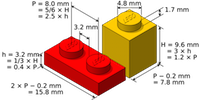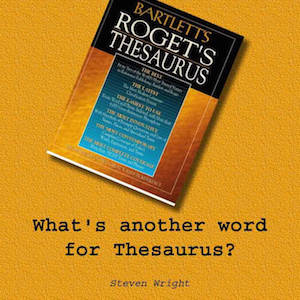1.7 Parts of Speech - Part One
| Site: | Cowichan Valley School District - Moodle |
| Course: | ELA5, CSS, Sferrazza |
| Book: | 1.7 Parts of Speech - Part One |
| Printed by: | Guest user |
| Date: | Tuesday, 16 December 2025, 10:51 AM |
Learning Targets
By the end of this lesson, you should be able to say YES to the following questions.

- Can I identify key parts of speech and understand their importance?
- Can I create more vivid and interesting parts of speech to make my writing more descriptive?
Words Create Worlds
|
Lego bricks via Wikipedia |
When you are writing, think of each word like a Lego piece. To be the best builder you can be, you should know about the tools and materials you are working with. |
Common & Proper Nouns
Nouns are the heart of descriptive writing. A noun is a person, place, thing, or idea – and that’s what you are describing in descriptive writing. Nouns can be broken down into the following groups:
- common nouns
- proper nouns
- concrete nouns
- abstract nouns
- Most nouns are common nouns and refer to people, places, animals, and things.
Examples: student, cat, school, language - Proper nouns are the names of specific people, places, animals and things. They begin with a capital letter.
Examples: Naomi Silver, Squamish, University of Victoria, Halq'eméylem
REMEMBER to capitalize proper nouns! This makes English teachers happy. (Notice how English is capitalized – all languages and nationalities are capitalized.)
Concrete & Abstract Nouns
 3) Concrete nouns are objects which we can see or touch.
3) Concrete nouns are objects which we can see or touch.
Examples: chair, computer, mountain, bead, electrician, flower, hand
**You want to have a variety of concrete nouns in descriptive writing. Concrete nouns are the easiest kind of nouns for people to visualize.**
4) Abstract nouns are ideas, feelings, and situations. You cannot touch them.
Examples: intelligence, happiness, homelessness, democracy, truth, beauty
_______________________________________

To brush up on your nouns, complete the task, Properly Print Proper Nouns, in your Learning Guide. Then, return to this online lesson book.
Pronouns
A pronoun is used instead of a noun. It's used as a shorter alternative to a longer noun and to avoid repeating the noun too often.
Examples: I, you, he, she, it, we, they
Nouns Before Pronouns
Use the common or proper noun in the first instance, before you use a pronoun in your descriptive writing.
Example: Ahmed won an award for his nature photographs. He beamed with excitement as he walked up to the stage.
| Pronoun as Subject | Pronoun as Object | Possessive Pronoun | Reflexive Pronoun |
| I | me | mine | myself |
| you (singular) | you | yours | yourself |
| she | her | hers | herself |
| he | him | his | himself |
| it | it | its | itself |
| we | us | ours | ourselves |
| you (plural) | you | yours | yourselves |
| they | them | theirs | themselves |
Know what pronouns are and keep track of how many you use. Combine sentences if you notice a repeat of pronouns.
Example: Her name is Taina. She has black hair. She has brown eyes. She has a ponytail.
Try instead...
Taina has brown eyes, and black hair in a ponytail.
Use Concrete & Specific Nouns
|
|
You want specific, concrete nouns to help your reader see what you are describing. Beware of vague nouns and overusing pronouns.
Example: Kaloni threw some stuff into her backpack. (Stuff is a vague noun.)
Try instead…
Kaloni threw a sword, her dragon-hunting manual, and a parachute into her backpack. (This tells the reader more and makes you interested in finding out what she is going to do next.)
Example: She saw it beside him. She took it from him. She walked away with it. (There are too many pronouns. This is pretty ho-hum.)
Try instead…
Minh saw the piece of chocolate cake sitting beside her sleeping father. The five-year-old girl couldn’t resist and snatched up the plate. Her mouth was full of frosting as she walked away with the delicious dessert.
(Check out all the specific nouns. This tells a much more interesting story.)
 Complete the task in your Learning Guide titled, 1.7 Keep an Eye on Pronoun Use!
Complete the task in your Learning Guide titled, 1.7 Keep an Eye on Pronoun Use!
Adjectives
An adjective describes a noun. It tells you something about the noun and helps build a stronger picture in the reader’s mind.
Ex.) humongous moose green eggs and ham
caring counsellor First Nations' land
Canadian women’s hockey fan fuzzy, red sweater
Let's look at the importance of good adjectives to create descriptive writing.
Ex.) This is a dog. (Very basic!)
Try instead...
This is a hyperactive, tail-chasing, three-legged dog. (Now you have a much more specific image of the dog to imagine.)
Use Active & Adventurous Adjectives
|
Adjectives: The Good, the Bad, and the Ugly Bad is bad. Good is bad. Ugly is bad. And one of the worst offenders is nice. They’re bad because they’re overused. Avoid using these adjectives in your descriptive writing. Choose more active and adventurous adjectives. To search out these new exciting adjectives, use the synonym feature in the spelling/grammar checker from your word-processing program or use one of the many free synonym finder sites online (with adult approval). You can also grab a thesaurus - yes, a real book! If you don't have one, see if you can sign one out from the local library. P.S. A synonym is a word that has the same or nearly the same meaning as another word. |
Thesaurus by Ray MacLean via Flickr |
 Go to your Learning Guide and complete the task titled, Adjective Challenge.
Go to your Learning Guide and complete the task titled, Adjective Challenge.

